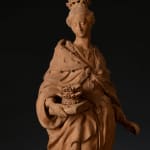
Jean-Baptiste van der Haeghen (Brussels 1688 - 1738)
Saint Elisabeth
Chapel of Our Lady's Hospital, Aalst.
Jean-Baptiste van der Haeghen (Brussels 1688 - 1738)
Terracotta bozzetti are like drawings in clay. (Perhaps that is why people who collect the one also tend to collect the other.) The present modello, with its masterful modeling of drapery and its fabulous depiction of various textures (the ermine cape!), is a prime example.
Jan-Baptist van der Haeghen was born in Brussels in 1688. In 1715, at age 27, he became a member of the guild of the so-called Four Crowned, the stonecutters and sculptors guild. Together with Jacques Bergé, he dominated the artistic scene in Brussels between 1725 and 1738, the year he suddenly died. As is evidenced by the long list of works he produced, he was very active both as an architect and sculptor. He produced works for parish churches and abbeys in Ninove, Aalst and many surrounding villages; he was also very active in Brussels, working on the decorations for the Miniemenkerk, the church of Notre-Dame du Finistère and the church of Saint-Nicolas, to name but a few of his projects. He carved, amongst other things, communion benches, altar decorations, pulpits and sculptures.
Stylistically, Jan-Baptist van der Haeghen is close to his contemporaries Jacques Bergé, Michiel van der Voort and Laurent Delvaux, with an elegant, refined and graceful style, true to the great tradition of Flemish baroque sculpture. To this day, the present work is one of only four known terracotta modelli by van der Haeghen, including two currently in the Royal Museum of Fine Art, Brussels, and one formerly in the collection of Arthur M. Sackler – all three are studies for a Saint Joseph with the Christ Child, which van der Haeghen sculpted for the church of Notre-Dame du Bon-Secours in Brussels. The present work is a preparatory study for the Saint Elisabeth which van der Haeghen made for the main altar of the chapel of the hospital of Our Lady in Aalst; according to archival research, the work was ordered in executed in Brussels ca. 1734. The present work thus should be dated around the same year. The modello is very finely sculpted, with many intricate details, notably in the corset and the ermine cloak, which falls from the shoulders in various elegant folds. As a baroque work with just a hint of classicism, it may be considered a very fine discovery and addition to van der Haeghen’s oeuvre.
Provenance
Private collection, Brussels.
Exhibitions
Ghent, 1913, Art ancien, n° 1251 (as Saint Helena).


